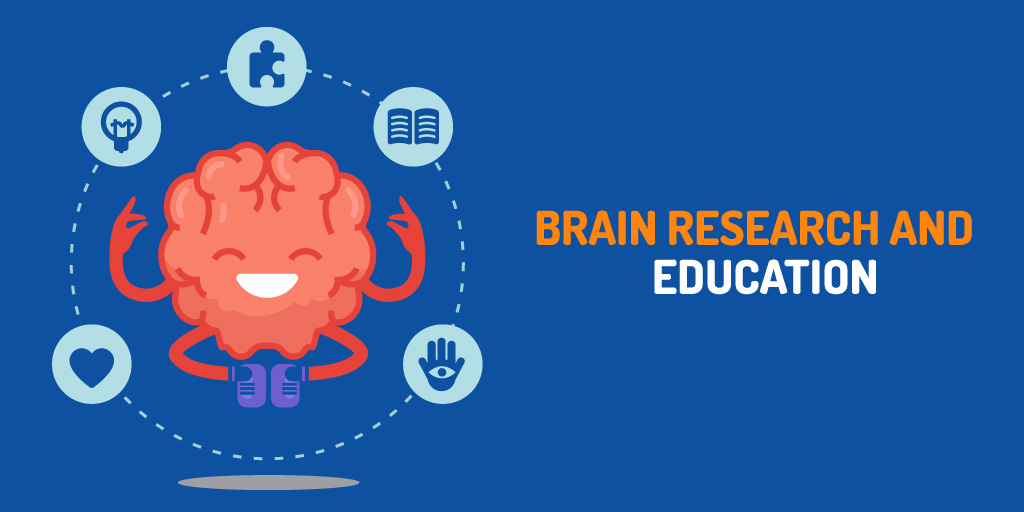
A lot has been written about brain research and education. It can sometimes be overwhelming to remember all the areas of the brain and their functions as well as the best ways to educate students with these functions in mind. Here is a crash course in brain development and some ways teachers can use this information to provide best practice teaching.
The brain is made up of three parts: the cerebellum, brainstem, and cerebrum. The cerebellum’s main function is to coordinate muscle movement and balance. The brainstem connects the cerebellum and the cerebrum to the spinal cord, which acts as a message center to send all kinds of important information from the brain to the body, including basic functions like breathing, eating, and sleeping.
The cerebrum is the largest part of the brain and is composed of the right and left hemisphere. This is a large part of where we teachers come in—trying to make that cerebrum grow, learn, and reach its optimal level of performance. Within the cerebrum, there are four lobes: frontal, parietal, occipital, and temporal. The surface of the cerebrum is called the cortex, which contains several billion neurons (nerve cells) that are arranged in layers acting as a mega-highway, making all kinds of connections throughout the different areas of the brain. We have nerve cells throughout our entire body and with each experience, neurons travel from one to another through synapses creating necessary learning and development in the brain.
Supporting Healthy Brain Development
This is the basic anatomy of the brain, but when we talk about metacognition, this is where our classrooms come into play. As educators, our job is to make as many connections as possible, creating synapses and a steady stream of neuron development. Here are some ways to create healthy brain development in your classroom:
- Build relationships within your classroom: The brain holds three different brain states. The executive state is where the brain can begin to learn (the cerebrum). However, before students can truly learn, both the survival state and emotional state must be satisfied (brainstem and cerebellum). Therefore, students need to feel loved and safe before they can even enter the executive state of learning. It is imperative to build relationships with your students. There are many successful socio-emotional programs and activities out there—find the one that works for you!
- Making connections: The brain learns and develops through connections, so try making connections throughout your curriculum. Many STEAM activities pull across the curricular subjects while under the umbrella of a larger topic. However, you can do this with any topic. Sometimes you may have to juggle and move around objectives, standards, and your yearly calendar to make it work. But by doing so, you have created a more connected experience, which will allow your students to absorb the information more successfully.
- Provide multiple sensory experiences: Since nerve cells are located throughout the entire body, providing several experiences where students can use as many senses as possible will add to their learning. Including more hands-on activities creates more synapses in the brain, which is a quicker way to learn and retain information.
- Minimize classroom decorations: I’m sorry Pinterest lovers, but having too many visuals can actually interfere with students’ focus and memory. Consider paring down the bright colors and loud posters. Of course, students love to see their own artwork on the walls as this creates a sense of ownership within your classroom community. So—dare I say—leave a couple of walls blank! Use a wall or two with needed information students can rely on for assistance and, finally, put up some student-created work.
- Teach about the brain to your students: It’s important for students to become self-motivators and in charge of their own learning. What better way to do this than to actually teach them about how the brain works? Once students can understand how the brain works, they may then be able to assess the best way for themselves to learn a concept or overcome a struggle. One great lesson to teach about the brain is neuroplasticity which is basically how your brain can change and grow through new experiences (i.e. everything you do in school). Also, the brain actually needs repetition and practice to retain information.
- Physical activity: Being physically active is not only good for overall health, it can also stimulate the birth and growth of new neurons as well as send oxygen throughout your brain. So, get outside! Recess is vitally important for our students. Older students need some type of exercise as well. If you can’t get your students outside, go to YouTube for some action videos or play some action CDs. Exercise also releases endorphins in your brain, creating an overall positive attitude—something everyone wants in the classroom!
- The brain and technology: Too much screen time can deter brain growth and development, not allowing for proper connectivity. The brain needs stimulation from the outside environment in order to thrive. Your brain needs proper stimuli in order to grow, just like your body needs food to live. Too much screen time can also lead to a lack of focus, a rise in ADD, lack of problem-solving skills, and impatience, just to name a few! With that being said, technology is here to stay and can offer a multitude of resources for our students—but screen time needs to be limited. In a perfect world, students should have one hour of screen time at school and one hour of screen time at home.
By knowing a little bit more about the brain, educators can do what we do best: teach! Hopefully this can add to your own pedagogy and philosophy, which in turn can add to your students’ education and success.
Want to stay up to date on the latest trends in education and education technology? Be sure to subscribe to our Educator blog!



